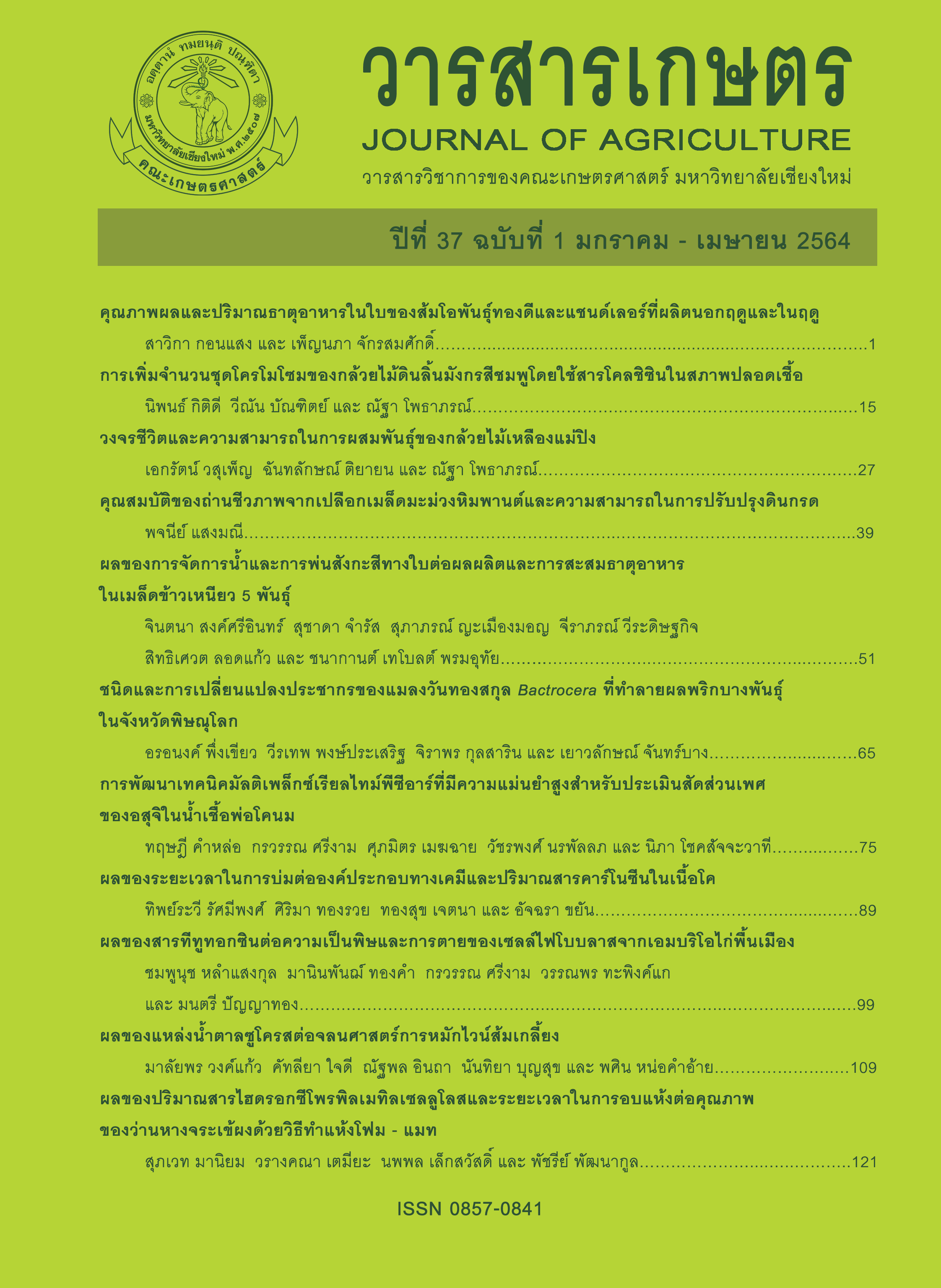Effects of Aging Periods on Chemical Composition and Carnosine Content in Beef
Main Article Content
Abstract
The objective of this study was to evaluate effect of aging period on chemical composition and carnosine content of beef. Fifteen muscle samples were taken from 3 crossbred [Charolais x (Brahman x Native)] bulls. Beef cattle was slaughtered at 24 - 36 months and average body weight was 500 - 600 kilograms. They were slaughtered following the standard procedure. Longissimus thoracis muscles were sampled and aging at 4 °C for 7, 14, 21 and 28 days. Chemical composition and carnosine content were analyzed. The results showed that the moisture, protein and lipid content (%) were not significantly different between groups (P > 0.05). Moreover, aging period was not an effect on carnosine content (P > 0.05). Therefore, it might conclude that the aging period had no affected on chemical composition and carnosine content of beef. Beef aging technique can improve value - added of meat without nutritional deterioration.
Article Details
References
AOAC. 2000. Official Methods of Analysis. 17thed. The Association of Official Analytical Chemists, Gaithersburg, MD.
Auh, J.H., N. Namgung, K.S. Shin, S.W. Park and I.K. Paik. 2010. Effects of supplementary blood meal on the content of carnosine and anserine in broiler meat. Journal of Poultry Science 47(4): 302-309.
Bogdanowicz, J., M. Cierach and T. żmijewski. 2018. Effects of aging treatment and freezing/thawing methods on the quality attributes of beef from Limousin × Holstein-Friesian and Hereford × Holstein-Friesian crossbreeds. Meat Science 137: 71-76.
Bauchart, C., D. Rémond, C. Chambon, P. Patureau Mirand, I. Savary- Auzeloux, C. Reynès and M. Morzel. 2006. Small peptides (< 5 kDa) found in ready-to-eat beef meat. Meat Science 74: 658-666.
Cho, S., S.M. Kang, P. Seong, G. Kang, Y. Kim, J. Kim, S. Lee and S. Kim. 2016. Effect of aging time on physicochemical meat quality and sensory property of Hanwoo bull beef. Korean Journal for Food Science of Animal Resources 36(1): 68-76.
D'Astous-Pagé, J., C. Gariépy, R. Blouin, S. Cliché, B. Sullivan, F. Fortin and M.F. Palin. 2017. Carnosine content in the porcine longissimus thoracis muscle and its association with meat quality attributes and carnosine-related gene expression. Meat Science 124: 84-94.
Dikeman, M.E., E. Obuz, V. Gök, L. Akkaya and S. Stroda. 2013. Effects of dry, vacuum, and special bag aging; USDA quality grade; and end-point temperature on yields and eating quality of beef Longissimus lumborum steaks. Meat Science 94(2): 228-233.
Epley, R.J. 1992. Aging beef. Minnesota Extension Service. University of Minnesota, St. Paul, MN.
Gariballa, S.E. and A.J. Sinclair. 2000. Carnosine: physiological properties and therapeutic potential. Age Ageing 29(3): 207-210.
Hipkiss, A.R., E. Baye and B. de Courten. 2016. Carnosine and the processes of ageing. Maturitas 93: 28-33.
Hobart, L.J., I. Seibel, G.S. Yeargans and N.W. Seidler. 2004. Anti-crosslinking properties of carnosine: significance of histidine. Life Sciences 75(11): 1379-1389.
Jaturasitha, S. 2008. Meat Technology. 2nd ed. Ming Muang Printing House, Chiang Mai. 335p. (in Thai)
Jones, G., M. Smith and R. Harris. 2011. Imidazole dipeptide content of dietary sources commonly consumed within the British diet. Proceedings of the Nutrition Society 70 (OCE6): E363, doi: 10.1017/S002966511100 4484.
Kim, M., J. Choe, H.J. Lee, Y. Yoon, S. Yoon and C. Jo. 2019. Effects of aging and aging method on physicochemical and sensory traits of different beef cuts. Food Science of Animal Resources 39(1): 54-64.
Li, C., G. Zhou and X. Xu. 2008. Changes of meat quality characteristics and intramuscular connective tissue of beef semitendinosus muscle during postmortem aging for Chinese Yellow bulls. International Journal of Food Science and Technology 43(5): 838-845.
Li, X., J. Babol, A. Wallby and K. Lundström. 2013. Meat quality, microbiological status and consumer preference of beef gluteus medius aged in a dry ageing bag or vacuum. Meat Science 95(2): 229-234.
Maikhunthod, B. and K. Intarapichet. 2005. Heat and ultrafiltration extraction of broiler meat carnosine and its antioxidant activity. Meat Science 71(2): 364-374.
Peiretti, P.G., C. Medana, S. Visentin, V. Giancotti, V. Zunino and G. Meineri. 2011. Determination of carnosine, anserine, homocarnosine, pentosidine and thiobarbituric acid reactive substances contents in meat from different animal species. Food Chemistry 126(4): 1939-1947.
Ripoll, G., P. Albert, B. Panea, J.L. Olleta and C. Sanudo. 2008. Near-infrared reflectance spectroscopy for predicting chemical, instrumental and sensory quality of beef. Meat Science 80(3): 697-702.
SAS. 2003. SAS STAT User’s Guide. Version 9.1. SAS Inst. Inc., Cary, NC. 5180 p.
Shi, Y., W. Zhang and G. Zhou. 2020. Effects of different moisture-permeable packaging on the quality of aging beef compared with wet aging and dry aging. Foods 9: 649. doi: 10.3390/foods9050649.
Smith, R.D., K.L. Nicholson, J.D.W. Nicholson, K.B. Harris, R.K. Miller, D.B. Griffin and J.W. Savell. 2008. Dry versus wet aging of beef: Retail cutting yields and consumer palatability evaluations of steaks from US Choice and US Select short loins. Meat Science 79(4): 631-639.
Stvolinsky, S.L. and D. Dobrota. 2000. Anti-ischemic activity of carnosine. Biochemistry (Moscow) 65(7): 849-855.


